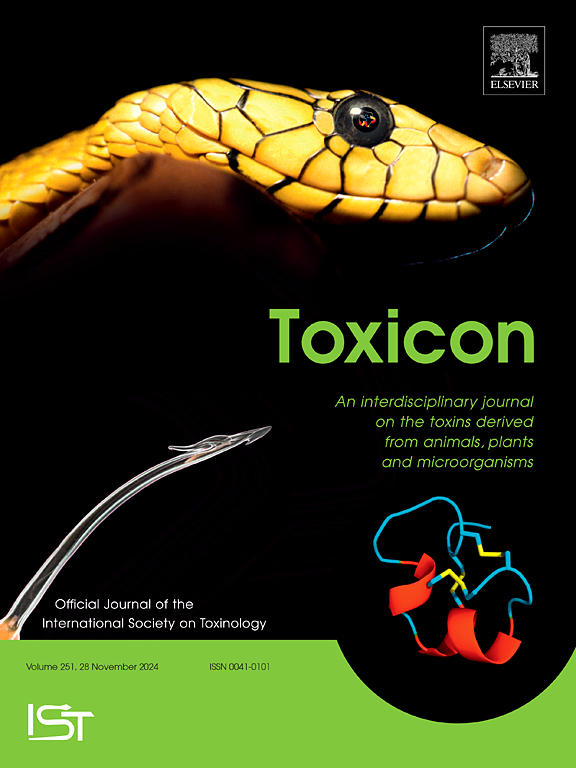来自巴西塞拉多的一种蝎子:毒液和血淋巴成分及生物活性的首次评估。
IF 2.6
4区 医学
Q2 PHARMACOLOGY & PHARMACY
引用次数: 0
摘要
在巴西,蝎子中毒是一个严重的公共卫生问题,蝎子蜇伤是最常见的由有毒动物引起的事故。蝎子的毒液是由不同种类的分子组成的复杂混合物,其中一些可能具有药理特性。本研究旨在研究南马托格罗索州特有物种巴拉圭提尤斯(Tityus paraguayensis)毒液和血淋巴的生物活性和成分。血淋巴分别显示与先天免疫和消化过程相关的蛋白水解和脂肪酶活性。虽然这些活性不被认为与毒化的表现有关,但它们可能在具有抗菌活性的化合物的前景中证明是有价值的。毒液显示磷脂酶和脂肪酶活性,并刺激(Na+,K+)- atp酶活性。还分析了该毒液对克氏锥虫附属体的活性。在本实验中,巴拉圭疟原虫毒液抑制了寄生虫的生长。毒液不会对Vero细胞产生细胞毒性。SDS-PAGE分析显示蛋白质范围在10 ~ 140 kDa之间,以及分子质量+通道配体(KTx)的条带。此外,通过鸟枪蛋白组学鉴定出5种与钾通道毒素相关的毒素、3种与钠通道毒素相关的毒素和1种金属蛋白酶。本文首次报道了巴拉圭瓢虫毒液的生物活性、高效液相色谱图谱、电泳图谱和蛋白质组学分析。这些发现提示巴拉圭蛛毒液可能是鉴定具有药理应用的分子的有价值的来源。本文章由计算机程序翻译,如有差异,请以英文原文为准。

Tityus paraguayensis, a scorpion from the Brazilian Cerrado: First assessment of venom and hemolymph composition and biological activity
Scorpionism is a serious public health problem in Brazil, where scorpion stings are the most frequent accidents caused by venomous animals. Scorpion venoms comprise a complex mixture of different classes of molecules, some of which may possess pharmacological properties. This study aimed to investigate the biological activity and composition of the venom and hemolymph of Tityus paraguayensis, an endemic species found in Mato Grosso do Sul State. The hemolymph showed proteolytic and lipase activities associated with innate immunity and digestive processes, respectively. Although these activities are not believed to be involved in the manifestations of envenomation, they might prove valuable in the prospection of compounds with antimicrobial activity. The venom exhibited phospholipase and lipase activities and stimulated (Na+,K+)-ATPase activity. The venom was also analyzed for activity against epimastigote forms of Trypanosoma cruzi. In this assay, T. paraguayensis venom inhibited parasite growth. The venom did not cause cytotoxicity to Vero cells. SDS-PAGE analysis revealed proteins ranging from 10 to 140 kDa, as well as bands with molecular mass <10 kDa, possibly corresponding to neurotoxic peptides. HPLC analysis of T. paraguayensis venom revealed that the highest number of peaks had retention times of 1–20 min (0–35 % acetonitrile). The partial sequence of peak 10 was determined by Q-TOF analysis and was partially identified as a peptide (Tp10) that possible act as a K+ channel ligand (KTx). Additionally, 5 toxins related to potassium channel toxins, 3 toxins related to sodium channel toxins and a metalloproteinase were identified by shotgun proteomic of T. paraguayensis venom. This is the first report of the biological activities, HPLC profile, electrophoretic pattern and proteomic analysis of T. paraguayensis venom. These findings suggest that T. paraguayensis venom may be a valuable source for the identification of molecules with pharmacological applications.
求助全文
通过发布文献求助,成功后即可免费获取论文全文。
去求助
来源期刊

Toxicon
医学-毒理学
CiteScore
4.80
自引率
10.70%
发文量
358
审稿时长
68 days
期刊介绍:
Toxicon has an open access mirror Toxicon: X, sharing the same aims and scope, editorial team, submission system and rigorous peer review. An introductory offer Toxicon: X - full waiver of the Open Access fee.
Toxicon''s "aims and scope" are to publish:
-articles containing the results of original research on problems related to toxins derived from animals, plants and microorganisms
-papers on novel findings related to the chemical, pharmacological, toxicological, and immunological properties of natural toxins
-molecular biological studies of toxins and other genes from poisonous and venomous organisms that advance understanding of the role or function of toxins
-clinical observations on poisoning and envenoming where a new therapeutic principle has been proposed or a decidedly superior clinical result has been obtained.
-material on the use of toxins as tools in studying biological processes and material on subjects related to venom and antivenom problems.
-articles on the translational application of toxins, for example as drugs and insecticides
-epidemiological studies on envenoming or poisoning, so long as they highlight a previously unrecognised medical problem or provide insight into the prevention or medical treatment of envenoming or poisoning. Retrospective surveys of hospital records, especially those lacking species identification, will not be considered for publication. Properly designed prospective community-based surveys are strongly encouraged.
-articles describing well-known activities of venoms, such as antibacterial, anticancer, and analgesic activities of arachnid venoms, without any attempt to define the mechanism of action or purify the active component, will not be considered for publication in Toxicon.
-review articles on problems related to toxinology.
To encourage the exchange of ideas, sections of the journal may be devoted to Short Communications, Letters to the Editor and activities of the affiliated societies.
 求助内容:
求助内容: 应助结果提醒方式:
应助结果提醒方式:


